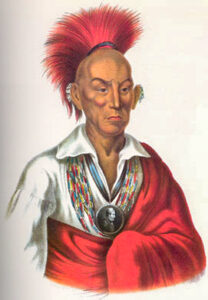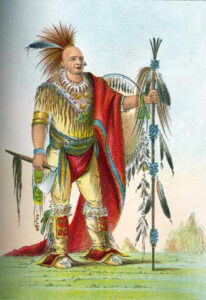Wisconsin History
The area our Van Matre family settled is in the current county of Lafayette in the state of Wisconsin. This Wisconsin History includes a timeline for the State and Lafayette County changes and a brief account of the Indian Wars for the area.
Morgan Van Matre’s son, Andrew Pierce “A.P.” Van Matre along with Jesse Shull, were two of the first white men to settle in the area. They both married “Fox” Indian girls which gave them protection from the Indians. After Jesse’s wife died, he later married A.P.’s sister Melissa Van Matre. You can find more about Jesse and Melissa Shull at my post Morgan Van Matre. You can find more about A. P. Van Matre in his post.
Wisconsin History: Place Name changes
Place name changes for the State of Wisconsin:
1783 – Officially US Control, reality British Control
1787 – Northwest Territory
1800 – Indiana Territory
1809 – Illinois Territory (except Door County Peninsula)
1818 – Michigan Territory
1836 – Wisconsin Territory
1848 – Became State of Wisconsin
Lafayette County Changes:
1818 – Crawford County, Michigan Territory
1829 – Iowa County, Michigan Territory
1846 – Lafayette County, Michigan Territory
1848 – Lafayette County, Wisconsin, USA
Wisconsin Counties Map – Lafayette County is on the southern border just north of Illinois. You can find a fun interactive Map of Wisconsin with timeline of changes at https://www.mapofus.org/wisconsin/.

Table of Contents
The United States acquired Wisconsin in the Treaty of Paris (1783). Massachusetts claimed the territory east of the Mississippi River between the present-day Wisconsin-Illinois border and present-day La Crosse, Wisconsin. Virginia claimed the territory north of La Crosse to Lake superior and all present-day Minnesota east of the Mississippi River. Shortly afterward, in 1787, the Americans made Wisconsin part of the new Northwest Territory. Later, in 1800, Wisconsin became part of Indiana Territory. Despite the fact that Wisconsin belonged to the United States at this time, the British continued to control the local fur trade and maintain military alliances with Wisconsin Indians.
The United States did not firmly exercise control over Wisconsin until the War of 1812. In 1814, the Americans built Fort Shelby at Prairie du Chien. During the war, the Americans and British fought one battle in Wisconsin, the July, 1814 Siege of Prairie du Chien, which ended as a British victory. The British captured Fort Shelby and renamed it Fort McKay, after Major William McKay, the British commander who led the forces that won the Battle of Prairie du Chien. However, the 1815 Treaty of Ghent reaffirmed American jurisdiction over Wisconsin, which was by then a part of Illinois Territory. Following the treaty, British troops burned Fort McKay, rather than giving it back to the Americans, and departed Wisconsin. To protect Prairie du Chien from future attacks, the United States Army constructed Fort Crawford in 1816, on the same site as Fort Shelby. Fort Howard was also built in 1816 in Green Bay.
Significant American settlement in Wisconsin, a part of Michigan Territory beginning in 1818, was delayed by two Indian wars, the minor Winnebago War of 1827 and the larger Black Hawk War of 1832. The timing of permanent settlement by our Van Matre family was impacted by these wars.
The Indian Wars
The Winnebago War 1826-1827
The Winnebago War started when, in 1826, two Winnebago men were detained at Fort Crawford on charges of murder and then transferred to Fort Snelling in present-day Minnesota. The Winnebago in the area believed that both men had been executed. On June 27, a Winnebago war band led by Chief Red Bird and the prophet White Cloud (Wabokieshiek) attacked a family of settlers outside of Prairie du Chien, killing two men. They then went on to attack two keel-boats on the Mississippi River that were heading toward Fort Snelling, killing two men and injuring four more. Seven Winnebago warriors were killed in those attacks. The war band also attacked settlers on the lower Wisconsin River and the lead mines at Galena, Illinois.[this is the area where A.P. Van Matre was at this time]. The war band surrendered at Portage, Wisconsin, rather than fighting the United States Army that was pursuing them.
The Black Hawk War 1832

At St. Louis in 1804, future president William Henry Harrison negotiated a treaty with two representatives of the Sauk nation who had come to the city on other business. When it was over, the government believed it had secured the right to open all Sauk lands east of the Mississippi to settlement, for a mere $2,500. Sauk chiefs back home in Illinois and Wisconsin, however, believed that the two negotiators had never possessed the authority to speak for the whole nation and that the treaty was therefore invalid. The Indians continued to inhabit their village of Saukenuk near the mouth of the Rock River, where they had lived since the mid-eighteenth century, near the Ho-Chunk village of Prophetstown.A quarter century later, lead was being profitably mined in the Rock River region and thousands of settlers were swarming to it without regard for treaties or the land’s original owners. Keokuk and other Sauk leaders who thought it was futile to resist overwhelming white military force complied with an 1829 government order to move across the Mississippi in return for enough corn to get through the winter. But when the government failed to honor its promises concerning this move, a group of about 1,200 Sauk under the leadership of Black Hawk (Ma-ka-tai-me-she-kia-kiak) returned to the Illinois side of the river in the hope of re-occupying their homeland and harvesting their corn. Black Hawk believed that the 1804 treaty was fraudulent, that his Ho-Chunk neighbors would join him in fighting the Americans if necessary, and in the event of full-scale war the British would also come to his aid.
None of his expectations came true, however. Instead of Indian and British allies, Black Hawk and his followers were met in the summer of 1832 by the Illinois militia, who were soon reinforced by regular U.S. Army troops. He found the corn fields of Saukenuk trampled by cattle and fenced by settlers. Together the American forces tried to pin down the Sauk warriors, women, and children, but beginning with the Battle of Stillman’s Run on May 14th, the Indians managed with great military finesse to escape and attempt a retreat. For 16 weeks Black Hawk and his warriors created tactical diversions while the noncombatants tried to make their way back to and safely across the Mississippi. Throughout the summer of 1832 they eluded capture by leading the Americans on a circuitous route around the populated lead region, through the future site of downtown Madison, across the Wisconsin where the Battle of Wisconsin Heights was fought, and toward the Mississippi above Prairie du Chien.
During this exodus several attempts to surrender were rebuffed or mis-interpreted by the American troops, and supplies of food and water repeatedly ran out. Many very young or elderly Indians died of hunger, thirst, and exhaustion and were buried on the trail. Warriors skirmished with the Wisconsin militia often enough to keep them at bay, but these engagements also kindled fear in the hearts of settlers and a desire for revenge in the minds of soldiers.

Finally, on August 1, 1832, the surviving Sauk finally reached the banks of the Mississippi near the mouth of the Bad Axe River. But rather than crossing to safety, they were caught in a crossfire between a gunboat in the river ahead of them and the pursuing troops on bluffs behind them. The next day, in the cruelly misnamed Battle of Bad Axe, the Americans again rebuffed a white flag of truce and instead indiscriminately massacred hundreds of men, women and children. The gunboat fired on defenseless swimmers as they attempted to retreat, until the Mississippi ran red with blood. About 70 Sauk made it across only to be killed by Sioux warriors, long-time enemies of the Sauk, fighting on the side of the Americans. Small scattered groups hid after the battle in the wilderness or in hunting camps of sympathetic Ho-Chunk. Black Hawk, after the rebuke of his council on the night of August 1, left his followers and surrendered to authorities at Fort Crawford. Of his initial community of 1,200 followers who had attempted to return to their homeland, only about 150 survived.
Black Hawk later dictated his autobiography, which includes an eloquent defense of his actions and an articulate statement of the case against U.S. aggression. After imprisonment, he was ultimately repatriated with the main body of his people in Iowa, who were then led by his rival, Keokuk. The display of overwhelming power by U.S. troops convinced most other Wisconsin Indian nations that Keokuk had been right, and after 1832 Wisconsin tribes offered no further organized military resistance to the U.S. government.2
Citations and Attributes:
- Wisconsin Counties Map. Public Domain, https://commons.wikimedia.org/w/index.php?curid=648225
- Wisconsin Historical Society website, Turning Points in Wisconsin History.
- Chief Black Hawk (Makataimeshekieakiah). By Charles Bird King – McKenney, Thomas Loraine and James Hall. History of the Indian Tribes of North America, with Biographical Sketches and Anecdotes, of the Principal Chiefs. Philadelphia: J. T. Bowen, 1848-1850. (1), Public Domain, https://commons.wikimedia.org/w/index.php?curid=2782692
- Keokuk. By Catlin, George – Catlin, George. North American Indians. Vol. 2. Philadelphia: Leary, Stuart and co., 1913., Public Domain, https://commons.wikimedia.org/w/index.php?curid=2782652
